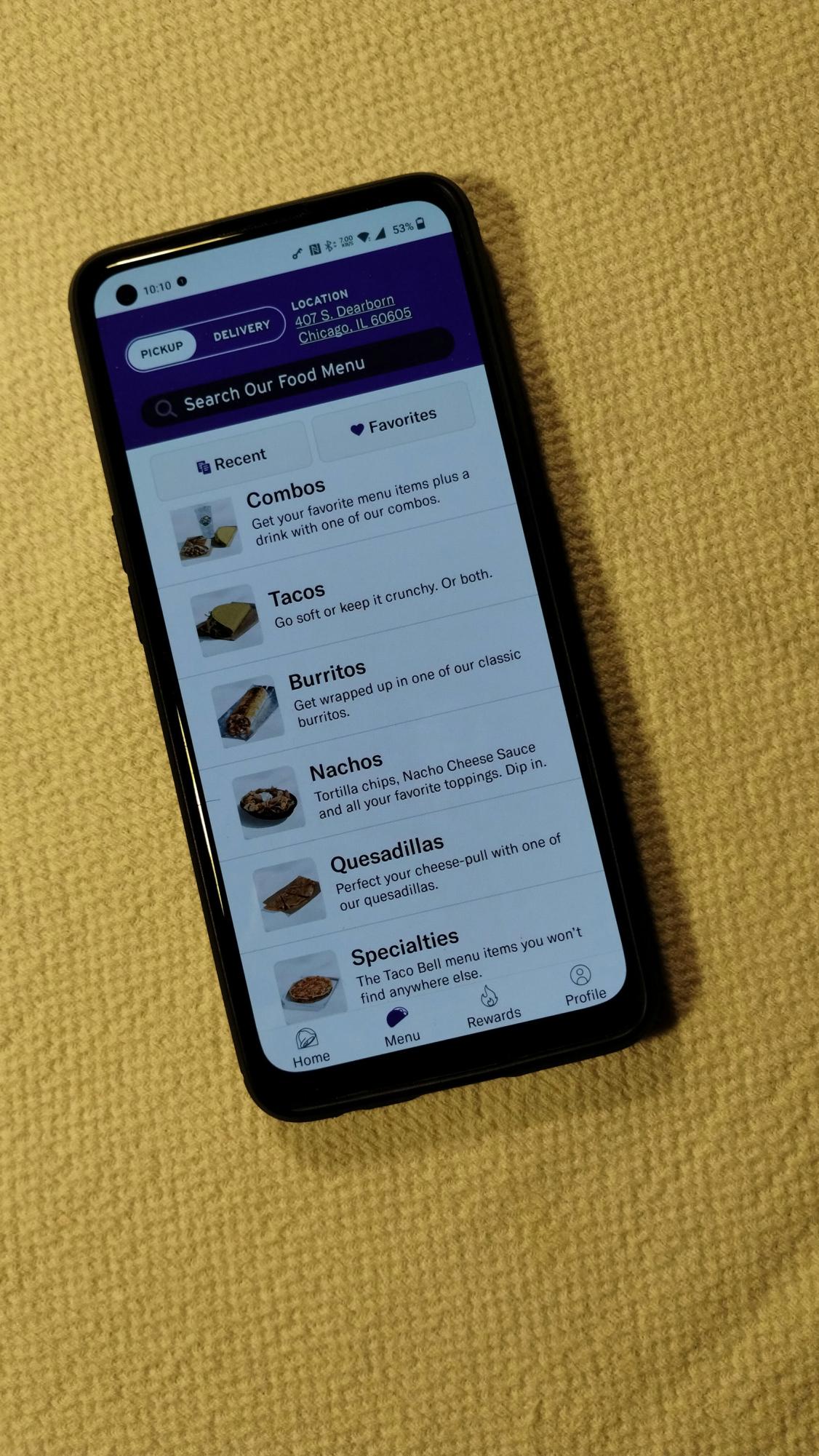Taco Bell is a Mexican-inspired fast food chain that offers multiple ways to order and pay for food at its locations. Taco Bell provides customers the opportunity to order food in-person, from a drive-thru, at the touch screen menu boards, in a web browser, and in the official app. As a person who eats mostly home-cooked meals, I have never found the need to use food ordering apps. However, I recently discovered the benefits of ordering food in this contactless manner from friends and family members. In my previous article about Taco Bell, I reviewed the food, but the app deserves a story of its own.
The app is convenient for both Android and iOS devices because it serves as a one-stop shop while on-the-go. The pick-up process can be done via in-store or drive-thru. Typically, I never use restaurant, grocery or shopping apps because most of my food consumption habits involve home-cooked and plant-based meals. But I considered using the Taco Bell app for several reasons.
The benefits of the app started with creating a new account. As a first time user of the Taco Bell app, I received a free offer of one of three options. I chose to get the most value item listed and wanted to test out the customization options within the app. I chose a Beefy 5 Layer Burrito, substituted the seasoned beef with black beans, and added red sauce. According to my receipt, it would have cost $4.69, but given I was a new app user, I got it for free.
The second benefit of in-app customization was the ability to view calorie counts for each modification in a clear and concise way. Calorie counts are clearly visible with every menu item, combo package, and add-on. According to Taco Bell’s Nutritional Facts and without any customizations, over 60% of food items are under 501 Calories. However, with very few exceptions, the remaining 40% of food items can easily be made healthier and contain fewer calories by substituting meat for beans.
It is in the customer’s best interest to click ‘customize’ regardless of dietary preferences because one should always be aware of all the ingredients before paying money for the order. Additionally, once the food is ready, it is too late to correct an accidental error on the customer’s side of the order. Each add-on costs between 30 cents and $1.50. The meat add-ons have higher prices than the veggie, sauce, or dairy add-on’s.
The app gives the ability to choose online exclusives that cannot be purchased in-person, such as the Cravings Boxes and family or friend meals. Both the app and web browser versions of purchasing food allow online exclusive deals.
For instance, a Black Bean Crunchwrap Supreme is $6.19, while the Veggie Build-Your-Own Cravings Box is $5.99. Both of these orders contain the identical Crunchwrap, but the Cravings Box gives three additional items while saving money. The individual item actually feels like a scam when comparing it to the Cravings Box.
Both the app and the web browser versions offered more similarities than differences. All ordering options were categorized, the experience was as simple as clicking the category, clicking the combo or item and either ‘customize’ or ‘add to order.’ Adding additional ingredients was as simple as clicking whatever the customer desired within the ‘customize’ option.
The app provides additional benefits that other methods of ordering do not offer. Upon close speculation of the app, it offers an ongoing point system to earn a free food item or meal. Eating at Taco Bell with higher frequencies will allow that customer to earn a free food item sooner. The rewards system is a simple enough business concept much like earning frequent flier points for airlines.
When awarded a free menu item, the customer has a choice of approximately three food items that are presented upon having sufficient points. This means the customer can enjoy a surprise treat that is different from their usual order.
For my order, I choose in-store pick-up every time. I am very apprehensive about using drive-thru because it caters to the lazy lifestyle of Americans. Thus, I boycott the drive-thru with a passion whenever possible.
Another benefit of the app was finding the nearest franchise to one’s actual location in an instant. This feature is especially useful because it would be a great inconvenience and shame to order from the wrong location than the one the customer plans on visiting.
The app gives the ability for customers to use Google Pay or Apple Pay instead of saving one’s precious credit card data within the app. These services offer another layer of security to the purchases. However, there is a downside because the customer has the ability to receive an incomplete version of the receipt either by email or text message.
A surprising benefit that I have encountered with app-based food orders is that the customized food does not appear to have errors. As a vegetarian, I have received many Taco Bell orders where errors are present within my customized meal orders. It has been a pervasive problem that we, as vegetarian and vegan customers, have dealt with.
These negative life experiences have taught us to treat staff members empathetically and talk politely to food handlers to redo the order without errors. If contactless food purchases become fully automated in the future, it may become a forgotten characteristic of fast food service within the test of time. It has been an experience to show customers that these are actual humans making the food, which was actually quite touching and empathetic while growing up.
With online ordering, the food ordering concept feels more robotic, and perhaps 30 years from now, fast food restaurants will be fully autonomous and robotic with no more than one human surveilling multiple franchise locations. It reminds me of one particular episode from my childhood of a science fiction cartoon, “The Adventures of Jimmy Neutron, Boy Genius”, where Jimmy reinvented a popular sandwich shop, McSpankey’s, into a fully autonomous restaurant, concocting food to the customers’ exact specifications. That may actually become a reality in our future, and only time will tell. As artificial intelligence becomes more prevalent, it only feels more likely.
Convenience, customizability, special point-based offers, exclusive online deals, the rewards system, location finder, secure payment options, and having fewer errors in my order were all of the benefits that I found using the official Taco Bell app. I recently tried ordering from Taco Bell in-person, and it felt archaic like traveling 20 years into the past. Whether people like it or not, technology will continue to be more pervasive in society.




